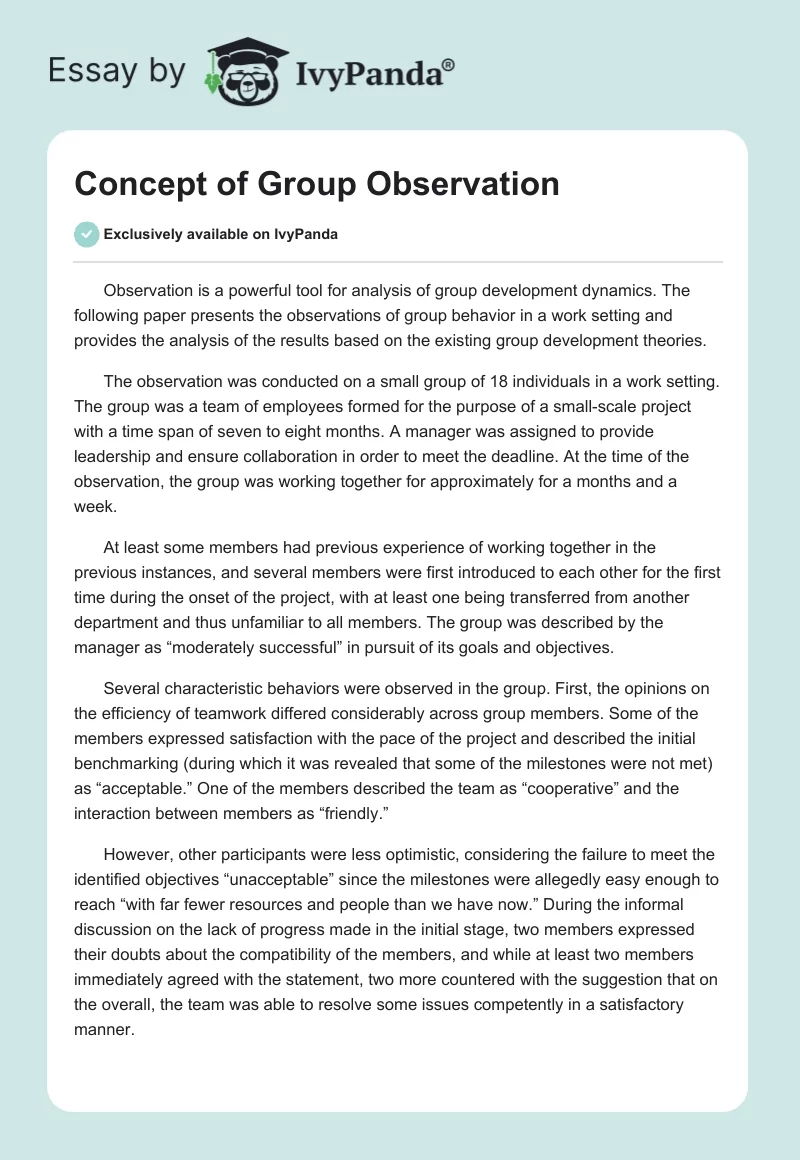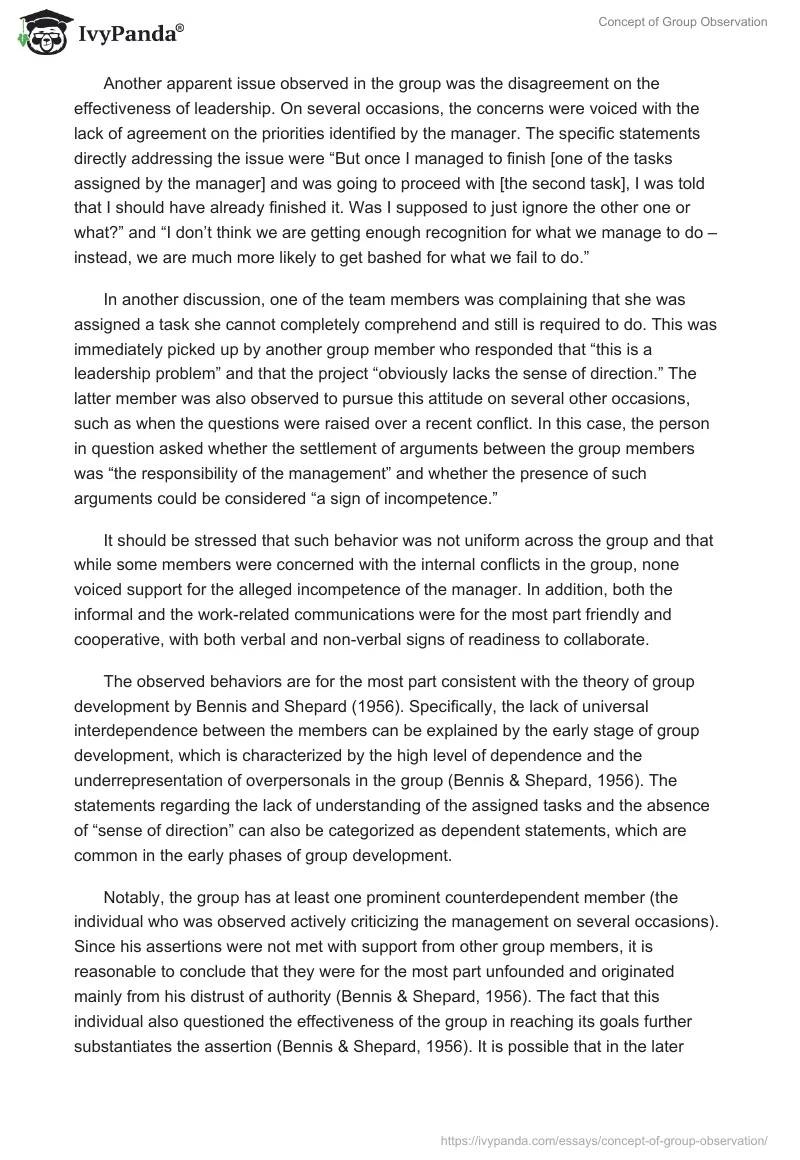Observation is a powerful tool for analysis of group development dynamics. The following paper presents the observations of group behavior in a work setting and provides the analysis of the results based on the existing group development theories.
The observation was conducted on a small group of 18 individuals in a work setting. The group was a team of employees formed for the purpose of a small-scale project with a time span of seven to eight months. A manager was assigned to provide leadership and ensure collaboration in order to meet the deadline. At the time of the observation, the group was working together for approximately for a months and a week.
At least some members had previous experience of working together in the previous instances, and several members were first introduced to each other for the first time during the onset of the project, with at least one being transferred from another department and thus unfamiliar to all members. The group was described by the manager as “moderately successful” in pursuit of its goals and objectives.
Several characteristic behaviors were observed in the group. First, the opinions on the efficiency of teamwork differed considerably across group members. Some of the members expressed satisfaction with the pace of the project and described the initial benchmarking (during which it was revealed that some of the milestones were not met) as “acceptable.” One of the members described the team as “cooperative” and the interaction between members as “friendly.”
However, other participants were less optimistic, considering the failure to meet the identified objectives “unacceptable” since the milestones were allegedly easy enough to reach “with far fewer resources and people than we have now.” During the informal discussion on the lack of progress made in the initial stage, two members expressed their doubts about the compatibility of the members, and while at least two members immediately agreed with the statement, two more countered with the suggestion that on the overall, the team was able to resolve some issues competently in a satisfactory manner.
Another apparent issue observed in the group was the disagreement on the effectiveness of leadership. On several occasions, the concerns were voiced with the lack of agreement on the priorities identified by the manager. The specific statements directly addressing the issue were “But once I managed to finish [one of the tasks assigned by the manager] and was going to proceed with [the second task], I was told that I should have already finished it. Was I supposed to just ignore the other one or what?” and “I don’t think we are getting enough recognition for what we manage to do – instead, we are much more likely to get bashed for what we fail to do.”
In another discussion, one of the team members was complaining that she was assigned a task she cannot completely comprehend and still is required to do. This was immediately picked up by another group member who responded that “this is a leadership problem” and that the project “obviously lacks the sense of direction.” The latter member was also observed to pursue this attitude on several other occasions, such as when the questions were raised over a recent conflict. In this case, the person in question asked whether the settlement of arguments between the group members was “the responsibility of the management” and whether the presence of such arguments could be considered “a sign of incompetence.”
It should be stressed that such behavior was not uniform across the group and that while some members were concerned with the internal conflicts in the group, none voiced support for the alleged incompetence of the manager. In addition, both the informal and the work-related communications were for the most part friendly and cooperative, with both verbal and non-verbal signs of readiness to collaborate.
The observed behaviors are for the most part consistent with the theory of group development by Bennis and Shepard (1956). Specifically, the lack of universal interdependence between the members can be explained by the early stage of group development, which is characterized by the high level of dependence and the underrepresentation of overpersonals in the group (Bennis & Shepard, 1956). The statements regarding the lack of understanding of the assigned tasks and the absence of “sense of direction” can also be categorized as dependent statements, which are common in the early phases of group development.
Notably, the group has at least one prominent counterdependent member (the individual who was observed actively criticizing the management on several occasions). Since his assertions were not met with support from other group members, it is reasonable to conclude that they were for the most part unfounded and originated mainly from his distrust of authority (Bennis & Shepard, 1956). The fact that this individual also questioned the effectiveness of the group in reaching its goals further substantiates the assertion (Bennis & Shepard, 1956). It is possible that in the later stages of group development the person in question will resolve his authority issues and become more flexible (i.e. the shift towards interdependent type).
The connections between the group’s capacity to resolve internal conflicts and the leadership qualities of the manager can be identified as the example of scapegoating. The most likely reason for assigning the authority representative the role of a scapegoat is the dissatisfaction with the recent benchmarking results. According to Gemmill (1989), such setting leads to intrapsychic conflict and, by extension, the desire to distance from the undesirable emotions and attributes (failure to meet the expectations, in this case). Simply put, an attempt to ascribe the underperformance of the team to a specific authoritative member allows the members to avoid the responsibility and reach emotional satisfaction.
However, it should be acknowledged that the attempt of scapegoating the leader was not accepted uniformly, which can be considered a sign of the capacity to accurately perceive each other and, by extension, to form a successful collaboration. Finally, the inconsistencies between the degrees of interconnectedness need to be addressed. While it can be considered a standard deviation within the system, it is also highly likely that such situation is prompted by previous collaborative experience.
For instance, the members who display a higher degree of cooperation and perceive the group as functioning on the high level of development may do so because of familiarity with certain co-workers (Wheelan, Davidson, & Tilin, 2003). While no analysis was performed that could establish the definitive relationship, several individual inquiries were consistent with this hypothesis. In other words, successful interdependence was more common among the participants of previous projects.
The observations were largely consistent with the established theories of group development, phases of group development, expected verbal statements, and involved personality types. It should be pointed out that some of the conclusions, such as the influence of time spent together on a project, could not be verified, and the effect of scapegoating was relatively minor, which limits the reliability of the reached conclusions. Nevertheless, the analysis allows identifying the observations as dynamics of the group as a system.
References
Bennis, W. G., & Shepard, H. A. (1956). A theory of group development. Human Relations, 9(4), 415-437.
Gemmill, G. (1989). The dynamics of scapegoating in small groups. Small Group Research, 20(4), 406-418.
Wheelan, S. A., Davidson, B., & Tilin, F. (2003). Group development across time: Reality or illusion? Small Group Research, 34(2), 223-245.


